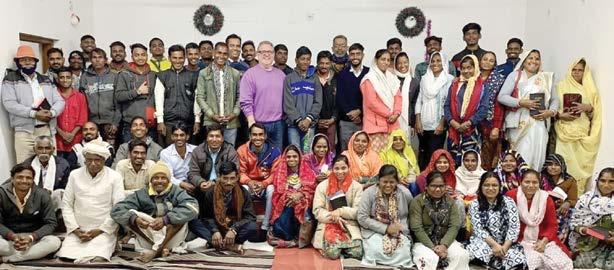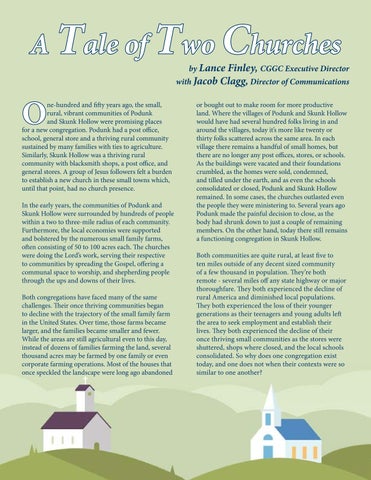a publication of the Churches of God, General Conference
Reimagining Ministry
IN THIS ISSUE
Our History of Reimagining by Jacob Clagg
Reimagining Funding for Missions by Ben Tobias
Reimagining Theological Education by Dr. Brent Sleasman
A Tale of Two Churches by Lance Finley with Jacob Clagg

Earnestly contend for the faith which was once delivered unto the saints (Jude 3b).
THE GLOBAL ADVOCATE (ISSN 0009-630X) is published bi-monthly by the Churches of God, General Conference.
Vol. 188, No. 2
Established June 5, 1835 as THE GOSPEL PUBLISHER, re-established on May 1, 1846 as THE CHURCH ADVOCATE, and re-established on October 1, 2019 as THE GLOBAL ADVOCATE.
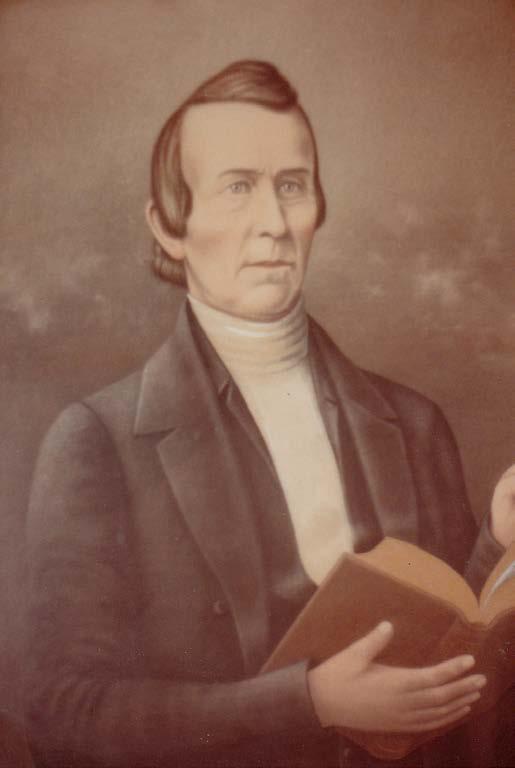 Rachel Foreman, Managing Editor
Rachel Foreman, Managing Editor
The Global Advocate, official publication of the Churches of God, General Conference, exists to encourage members of the CGGC to maximize their collective potential for Kingdom impact.
Correspondence: Address correspondence to The Editor, The Global Advocate, Churches of God Publications, PO Box 926, Findlay, OH 45839, or email to RachelF@cggc.org
Periodical rate paid at Minster, Ohio.
Postmaster: Send address changes to THE GLOBAL ADVOCATE, PO Box 926, Findlay, OH 45839.
© 2023, Churches of God, General Conference
Our HISTORY of REIMAGINING
by Jacob Clagg, Director of CommunicationsOur Bi-Centennial, the 200th anniversary of the Churches of God, General Conference as a denomination, will be in 2025. So, naturally, this is a time of reflection on our history. We're sifting through the archives, dusting off centuryold books, pamphlets, and letters. We're doing this not just to reminisce, although holding history in our hands is sometimes a gift in itself; instead, we're digging into our past to rekindle a revival and a reimagined spirit for the sake of our future. This venture has begged us to ask questions like, "Where have we reimagined in our own history? Where are the points of catalytic change? Where are the visions that spearheaded new movements? When were the revivals that asked much and produced more?
While we’ve been using the word “reimagine” for the past year as our most recent slogan, it’s not new. The CGGC has been reimagining itself many times over for the last 200 years, and the ethos behind “reimagine” has also been behind, to some degree or another, every revival, reconstruction, and reformation of the Christian church since the beginning. Monastic communities sprung up in the late 3rd century, and Ascetics had already withdrawn from a life of community well before that. In stark contrast to these escapist movements, the adoption of Christianity as the official religion of Rome under Constantine does represent the kind of sweeping reimagining of how Christianity might be practiced and understood. Likewise, the Protestant Reformation may be the single largest reimagining in the Church's history, radically changing the direction of many believers and reshaping the continent of Europe indefinitely.
In each of these examples, we see that reimagining comes with certain pain points. The ascetic and monastic movements certainly reimagined how Christianity should be practiced, and it did develop profound adherence in these communities, but it was also a rejection of the rest of society, which left many people unable to be ministered to. On the other hand, Christianity's ascent to an empire-wide religion decreased Christian persecution, and it was never more free to evangelize, but many Christians were also compelled to compromise their beliefs for the benefit of the empire, and the temptation to conquer in the name of God was realized. Even the Protestant Reformation, ostensibly meant to restore Christianity from corruption and give the faith back into the hands of common folk, ultimately splintered the faith into 20,000 different denominations. Even when reimagining has good intentions, it sometimes comes at a great cost.
I could go on, speaking at length about the long history of reimagining and renewal in our own denomination, and in fact, a prior draft of this article did exactly that. But as I dug through filing cabinets of old archived documents, I came upon a certain quote that smacked me directly in the face. The quote came from a booklet commemorating
the 150th anniversary of the CGGC called Time for Review, written in 1975. Richard E. Wilkin, the first Administrator of the CGGC from 1970 - 1987 (the longest tenure of any administrator/executive director), said,
When the church’s past becomes more intriguing than the church’s present or future, the church is in trouble. A very real peril is ours if we attempt to live in the past. It is possible to spend so much time in reflection and memorializing the past that we neglect our ministry in the present. In our celebrations we must remember that God is not finished with anything He is doing in His church and in the World.
And so Wilkin cuts a fine line between appreciating our history and becoming stuck in it. Likewise, there is a temptation to see our history as something to live into, or to recapture. “Gone are the glory days,” we sometimes say, and in many ways, that might be true. But what do we lose sight of when our eyes are cast backward, and our hands grope for bygone accolades? In chasing the renewal of our denomination, what other work gets left undone? Wilkin responds to this question too.
A church that is interested only in its selfreformation has overlooked the pulse and throb of the Word of God given on behalf of the world (society).
And he goes on to say that,
The church often talks mostly of itself, its structure, its doctrine, its name, its unity, its forms of worship, its buildings, etc. What would happen if we began not at this point not with the church, but the world? If we said.. “Who are the hungry, the blind, the captive?” The holy spirit never closes our hearts or our minds, but He tears us open continually for the sake of others, for the sake of community.
What is so striking to me about Wilkin’s quotes is that the language used and the problems
addressed, even 50 years later, have not changed. The serious challenges the church faces were present and discernible even then. The inability of the denomination to make solid headways into cities, where populations are rising the most, was recognized even then, and in fact was recognized back in 1925. The pessimist in me looks at that and concludes that we are stuck in a conceptual rut. If the challenges remain the same, and our solutions and visions remain the same, then aren’t we destined for the same results? Will we still be talking about the same unsolved problems in another 25 or 50 years?
The optimist in me says that this is just the way of the world. There are always challenges, and until Christ returns, we will not overcome all our obstacles. That people are still resistant to the gospel and that the church still finds itself on the backfoot is an affirmation that we do not live in dangerously unique times, nor are our challenges dangerously unique. The context is different, and the methods we employ will have to be different, but the task and the challenge has always been the same, to preach Christ and to minister to a people who very often want nothing to do with us. As our denomination has for the last 200 years, and so to Christendom for the last 2000, we are to love people and to show them that the love of Christ is our very aim.
So let me ask the question differently. Instead of just asking, “Where has the denomination reimagined in the past?” let’s ask, “How has the denomination reimagined for the sake of God’s people?” I think I’ve found four examples that run deep into our past and might motivate us to make equally colossal shifts in the future.
First, one of the denomination's defining positions, while not entirely unique, was firmly planted in 1845. John Winebrenner and the General Eldership of the denomination affirmed in a document called the Resolutions on Slavery that “the system of involuntary slavery, as it exists in the United States of North America, is a flagrant violation of the natural, unalienable and most precious rights of man, and utterly inconsistent with the spirit, laws and profession of the Christian religion.” The insistence upon abolitionism was incredibly controversial, especially because the resolution also suggested slave-owning members of the Churches of God be “excommunicated.” Here we find the denomination, even early on, at the bleeding edge of public theology, and what it means for a church to be fully committed to the transformation of not only people, but the culture those people live in. Here we find a church that is invested in redeeming the world around it. This type of reimagining pushed the church to ultimately take a particular side in what would become a massive civil war. Richard Kern writes in Time for Review that:
“The vast majority of ministers and laymen in the Church of God, prior to 1861, were opposed to both slavery and war… when a choice had to be made most minsters and laymen abandoned their pacifism and supported 'Mr. Lincoln’s War' and the Union.”
Second, during this same era, the denomination licensed Martha Jane Beecher for ministry in 1858. This would, like the ardent support of abolitionism

before it, put the denomination at the door of certain controversies, but would also be one of the defining pillars of the denomination, its support for women to use their God-given gifts for the sake of the Kingdom. It’s important to note that this puts the CGGC’s historic support of women decades ahead of many mainline Protestant denominations. The denomination would put to the test the idea of a priesthood of all believers, mobilizing whoever was willing into ministry for the Kingdom. From then to now, as it becomes more difficult to find quality Christian leadership, the church ought to be utilizing every willing person that God has called into ministry.
Third, with this precedent, Clara Landes was able to launch the CGGC’s first international mission in Uluberia, India, in 1898. The legacy of Clara Landes has continued on as our fields overseas flourish. The CGGC’s representation from other fields is so influential that the denomination's name was changed from its original name, Church of God in North America, to reflect our broader global makeup. By 1904, the mission in Bogra, India (now Bangladesh) was established by Viola Hershey and A.C. Bowers, and this field now operates 20 schools, 2 medical clinics, and well over 100 churches. The CGGC hasn’t stopped there; since then, we’ve started missions in Argentina, Brazil, Chile, Dominican Republic, Haiti, Kenya, Nicaragua, and Venezuela because we believe God is trying to redeem the whole world, and we want to be a part of that.


Fourth and last, the establishment of two educational institutions, Findlay College in 1886 (now University of Findlay) and a denominational seminary in Winebrenner Graduate School of Divinity (now Winebrenner Theological Seminary) in 1942, clearly affirms the denomination's values. The creation of legitimate and well-equipped schools was another step in reimagining how the Churches of God might have kingdom impact, both in the realm of ministry training at the Winebrenner Theological Seminary and in secular work at the University of Findlay. Education is one of the most powerful tools in reshaping the world around us. These institutions are cultivating people who are prepared to tackle the deep issues (theological or otherwise) of our time.

Each of these reimaginings reshaped the nature of the denomination. A CGGC without our abolitionist history, without women in ministry, without a heavy emphasis on global missions, and without our affiliation with UF and WTS is a CGGC that is unrecognizable. That’s the wonderful thing about reimagining; it makes it impossible to imagine what life was like before or without.
Where we go from here is hard to say. Maybe it means spreading the gospel through house churches that challenge the traditional model of church. Maybe it means more recovery ministries that focus on restoring dignity to people. Maybe it’s both of those and a hundred other things. But whatever we imagine or dream up, the mission statement couldn’t be any clearer. We need to reimagine our churches to maximize their impact. We need to mobilize all people in our churches, regions, and fields for daring action that starts new creative ventures in the same way that we started education centers in the past. We need to be the church that doesn’t just reject the culture, but the church that transforms it.
Reimagining
MissionsFunding for
by Ben Tobias, Director of Global ReachFunding for missions has changed a great deal in the past 125 years! Until 1994, mission fields and missionaries were funded by what we now call the “Cooperative Budget,” which is funded by church and conference apportionments (tithes in some cases). When Gordon & Annie Avey went to Brazil in 1994, the era of “faithbased support” began in the CGGC. Now missionaries are responsible for raising their support – both prayer and financial – and Global Reach assists in their training and oversight. This has resulted in a large expansion of new mission endeavors. Below is a chart that provides a historical overview of CGGC missions and the number of missionary families and individuals sent to each field. (Fields in boldface are now led by national leaders.)
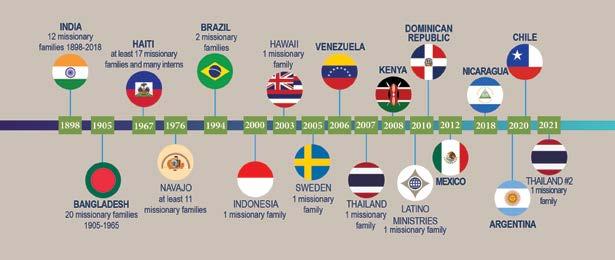
Do you see the change following 1994? A veritable “explosion” of mission happened, largely due to faith support. For the first time ever, new fields could be explored without needing to fit within the limits of a pre-existing cooperative budget. Faith support allowed missionaries to dream and explore God’s call.

The Next Wave:

It’s impossible to know how many millions of dollars have poured into CGGC mission efforts over the past century, but we want to highlight these important facts in the chart on the right.
“Infrastructure” refers to funds given to help pay for a wide variety of necessary field expenses like security, maintenance & utilities, and construction. This accounts for almost 2/3 of total designated giving. The call-out pie chart shows the amounts budgeted for missionary support, field leader support, evangelism & church planting, and education.
1. Of the $1.78 million expenses for the 2023 Designated Budget, $606,900 (or 34%) is designated for missionaries, national field leaders, evangelists, and church planters, and education support.

2. American missionary support accounts for less than HALF of all Leadership and Education funds (46%). This is significant because it clearly shows that we are investing more and more funds into national leaders, evangelists, and church planters, AND we seek to help students of all ages to grow in their faith.






The next wave of missions funding focuses on a “both/and” approach. We want to continue sending and supporting missionaries from churches in the USA, and we also want to support our international field leaders and national evangelists. Many of these brothers and sisters serve in countries where they face persecution, and we are unable to share their names, faces, and locations because of the danger they face. As you might know, ten of our international fields are led by nationals—not cross-cultural missionaries—and we are asking God to raise up support for them.




Your generous support will let them know of our love and support for them. They'll be encouraged by the knowledge of a large spiritual family backing them up. These brothers and sisters give vital leadership to the ministry that is taking place throughout the world, often in very challenging circumstances. Their deep faith, devotion, and love for Christ and their commitment to obediently demonstrate and proclaim the Good News of Jesus Christ in their own countries are inspiring and help to transform people's lives. We have the privilege to partner with these brothers and sisters as they help advance the work of the kingdom of God. Your partnership and support are an encouragement to them, and it also helps provide critical resources needed to ensure that the ministry continues to thrive and grow!
As Hebrews 13:16 says, "... do not forget to do good and to share with others, for with such sacrifices God is pleased." Praise God for raising them up, pray for their ministry, and give generously!
Theological Education at Winebrenner Theological Seminary: Establishing Cultural Priorities
by Dr. Brent Sleasman, WTS PresidentSince becoming President of Winebrenner Seminary in December 2015, much of my time has been spent on day to day items required for operating a seminary. All of these items are guided by our mission and strategy and serve the greater purposes of God’s kingdom. Focusing on operational items has made sense in light of the internal challenges that were present when I arrived, along with the external challenges of a global pandemic and changing role of higher education in North America.
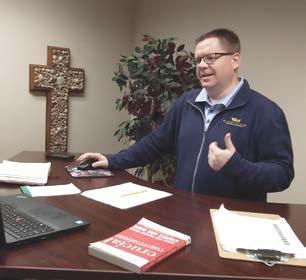
At a recent off-site Quarterly meeting, I shared with our faculty and staff that it is now time to shift to prioritizing organizational culture and recognize that healthy organizational practices emerge from a healthy culture.
Peter Drucker is credited with the statement, "Culture eats strategy for breakfast.” His point is that organizational culture always “wins” when there is conflict between various priorities. There are many definitions of culture –one helpful way to think about culture is provided by Andy Crouch in Culture Making: Recovering Our Creative Calling, where he writes, “Culture is what we make of the world – we start not with a blank slate but with all the richly enculturated world that previous generations have handed to us” (73).
There are times that culture can be aspirational in which we dream about what life could be like in the future. Think about someone like Martin Luther King Jr. speaking a particular kind of culture into existence with his “I have a dream” speech. However, we will often find that seeds of our culture are already present, but we haven’t yet brought them together and named them clearly.
In the first few chapters of Genesis, we see God’s power evident in creation. In Genesis 2:20, one of Adam’s first acts is to name the animals in God’s creation. Unfortunately, in our efforts to build and develop organizational
cultures, we often fail to name the important elements and miss an important step in the process of creation. In this article, I name various elements of the culture of Winebrenner in an effort to identify the ways that God is at work in our midst. As Andy Crouch suggests in the previous quote, we are not developing these elements out of thin air but are building upon our inherited narratives and traditions. The work of Jesus is central to all we do and, therefore, we will spend time anchoring each cultural commitment within the words of Jesus in the Bible. If culture is “what we make of the world,” then there should also be evidence to demonstrate how the culture is lived out.
The first cultural cornerstone of Winebrenner Theological Seminary is stewardship
There’s no question that the experience of a Winebrenner student in 2023 is very different from previous eras. I began my studies at Winebrenner Theological Seminary in the fall of 1996. As a member of the Allegheny Region of the CGGC, I was fortunate to receive full reimbursement for my tuition. My home church, the Indian Head Church of God, also had a small scholarship available for students who attended the University of Findlay and Winebrenner Theological Seminary. When I graduated from Winebrenner in 1999, I had not accumulated any additional financial debt during my time in seminary because of the generosity of these bodies.
Much has changed for students at Winebrenner Seminary over the past 25+ years. We, at Winebrenner, are committed to offering an affordable education to those who respond to God’s call to kingdom service. But, unfortunately, the financial challenges faced by churches and denominations have greatly minimized their ability to subsidize the education of interested students. In 2020 Winebrenner’s tuition was changed to $300/month and continues to allow Winebrenner to offer affordable, accessible, and high-quality graduate-level tuition. Our commitment is that no student should be unable to pursue God’s call due to lack of funding, and we are committed to assisting each student in finding the funding to continue their educational journey.
One of our commitments is to create an environment in which those called can pursue that call without taking on unnecessary financial burdens. Perhaps you’ve heard some variation of the phrase “God equips those he calls.” Since the mission of Winebrenner is to equip leaders for service in God’s kingdom, we should pay special attention to those who fit within either category –the called or the equipped! When seminary is part of a person’s call, every person called by God should have the necessary funding to pursue that call.
In order to fulfill this commitment, Winebrenner has made many difficult decisions to intentionally lower our overall operating costs. Since 2015 we’ve lowered our annual expenses by almost one million dollars. We continue to prioritize being good managers of what God provides.
A second cultural cornerstone of Winebrenner Theological Seminary is discipleship.
The invitation to approach theological education as discipleship is accompanied by the challenge to align our daily activities and decisions with those of Jesus. Some of the last recorded words of Jesus are found in the book of Matthew 28 when he says in verse 19, “…go and make disciples of all nations…” This is part of a larger passage of scripture often called the “Great Commission” and is considered a key teaching of Jesus. Since we’ve identified discipleship as a key component of Winebrenner’s culture, what are a few coordinates for better understanding this teaching of Jesus?
There are many helpful interpreters of this teaching, but I find the work of Mike Breen, founder of 3dm and author of multiple books, including Building a Discipling Culture, especially helpful. Breen writes that Jesus invited “his followers into an intimate relationship with him while also initiating a direct challenge to behaviors he knew were either wrong or unhealthy” (17).
For example, in Matthew 11:28-30, Jesus is recorded as saying, “Come to me, all you who are weary and burdened, and I will give you rest. Take my yoke upon you and learn from me, for I am gentle and
humble in heart, and you will find rest for your souls. For my yoke is easy and my burden is light.” What an invitation!
But a few chapters later in Matthew 16:24-25, Jesus says, “If anyone would come after me, he must deny himself and take up his cross and follow me. For whoever wants to save his life will lose it, but whoever loses his life for me will find it.” A very challenging teaching.
We see this rhythm throughout the teachings of Jesus. Invitation. Challenge. Invitation. Challenge.

There are many ways that this understanding can be incorporated and expressed in a context that prioritizes theological education. Since my primary tasks are related to administration, I only teach occasionally at Winebrenner Seminary. However, when I do teach, I begin almost every class session with something that resembles this understanding of discipleship. Currently, I am co-teaching with Dr. Kim Shifler a course exploring biblical interpretation and begin almost every next session by asking those enrolled to take a few minutes and reflect upon
• What did you find as an encouragement to your discipleship journey?
• What did you find as a challenge to your discipleship journey?
Depending upon the content of the particular course, almost every class provides some connection to the topic of the evening. Biblical studies invite opportunities to see this rhythm in the life of the followers of Jesus. Leadership invites conversation about how our days are often filled with invitations and challenges to our leadership styles. History, theology, counseling, etc., all have some elements of invitation and challenge.
Even the classroom experience itself falls into the rhythm of invitation and challenge. The root for discipleship and the root for discipline are shared. Discipleship requires an element of discipline. As we discipline ourselves to see how God invites and challenges us in our spiritual journey, we have the opportunity to
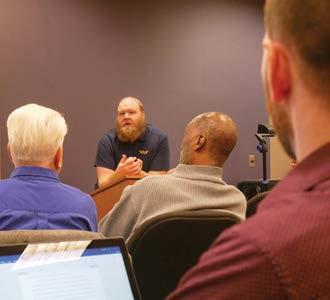
continue to grow in our relationship with Jesus and our understanding of discipleship.
The dual commitments to stewardship and discipleship name two of the areas of biggest change over the past few decades at Winebrenner. As a collaborative partner with the CGGC, Winebrenner remains committed to working with the current and future generations of kingdom leaders. This extends far beyond just those training to serve as pastors or missionaries, although we continue to train and equip many who are called to these roles with the church.
There are many within the Churches of God, General Conference, who either graduated from Winebrenner Theological Seminary or attend a church with a pastor who graduated from Winebrenner. Since first being established in 1942 as the Graduate School of Divinity at Findlay College—now the University of Findlay—Winebrenner has been training and equipping leaders for service in God’s kingdom. A significant portion of Winebrenner’s revenue comes from the generosity of givers from the CGGC, so it’s imperative that you know what we value as we follow the Spirit’s leading.
Reimagining Our
ChurchPlaces
by Lance Finley, CGGC Executive DirectorMany of our churches have under-utilized space, or maybe even entirely unused space. Perhaps you’ve thought of how to put that space to work during the Monday-Saturday timeframe when that space is mostly unoccupied or underutilized. You might dream about leveraging the existing bethel to meet a need in the community, such as operating a food or clothing pantry or opening a homework center or afterschool program. Maybe it would involve utilizing space in the facility to create a third-space in your community where people might gather and meet, such as a coffee house, laundromat, or café. In fact, we explored these very ideas in the September/October edition of The Global Advocate. All of these are necessary and important as we think about space and reimagining how we might use what the Lord has blessed us with for kingdom purposes.

March 2023 Global Advocate Prayer Calendar
4 Happy Birthday Haley Day! Praise God for her as she continues to serve him in the Southwest.
3 Bless the leaders of the CGWM as they minister to women at the Flourish Conference , this weekend in Findlay, OH.
2 Ask the Lord to bless Pastor Denis Droicin in Haiti as he provides a connection between the Haiti Conference and Project Help.
1 Seek God’s wisdom for the leaders of the Mexico Conference and the Latino Ministries Director who provides counsel.
11 Remember to pray for your neighbors who don’t know the Lord, and ask God to provide opportunities to befriend them and show Jesus’ love.
10 Pray for the ACTS Teams and those making decisions to apply as deadlines approach. Pray for life-changing opportunities to be seized!
9 Lift up Dr. John Costa in Bangladesh as he visits remote villages.
8 Pray for Pastor Joseph Mwaura as he leads the Voice of the Gospel ministry in Kenya. Ask God to raise up godly leaders!
7 As you interact with businesses today, pray for God to bless them and look for opportunities to honor Christ.
6 Intercede for the Global Reach Commission as they meet this evening. Seek God’s guidance in all decisions made.
5 Pray for unity between churches: “they will hear My voice; they will become one flock with one Shepherd” (John 10:16).
18 Call on the Lord’s blessing for Pastor Ernesto Nunes and the Brazil Conference.
17 We are at war! Intentionally pray for God’s protection and power as you consider the battles you and others are fighting. Our God is great!
16 Lift up in prayer Bryan & Katie Crabtree as they serve as missionary interns in Thailand while raising their two daughters.
15 Intercede for the CGGC Administrative Council as they continue to meet today. Pray for the Holy Spirit to guide in all decisions made for God’s glory!
14 Happy Anniversary, Rod & Mila Ayers! Thank God and ask Him to bless Rod & Mila’s work with Sister Churches and Schools.
13 Pray that international guests (tourists, students and business people) will be warmly welcomed and see Christ reflected by Christians.
12 Pray for India field director, Samir Singha as he ministers to families and that he would be an example of Christ’s love.
25 Pray for Army Chaplain Byron Denman and his family as they minister in Colorado.
24 Cities are important centers of culture & influence. Ask God to raise church planters who understand the unique needs and opportunities, and support their ministry.
23 The prodigal son “ came to his senses ” and returned home. Pray for the many young people who are wandering far to come back. Welcome them!
22 Happy birthday, Toni Thumma! Intercede for her as she serves alongside John in ministry at Hooghan Nizhoni.
21 Intercede for your local homeless shelter , and learn how you can help their ministry through volunteering and financial support.
20 Mondays often are “days off” for pastors. Pray for YOUR pastor today to be blessed with peace and encourage them as they minister.
19 Christ is our peace (Ephesians 2:14). Pray for the broken relationships in your church and community, and seek to encourage them to be open to the Holy Spirit.
31 Thank God for the ministry of Dave & Kenda Kapaku. Petition to God for right words and understanding as they minister.
30 Pray for India’s Mission Children that they would continue to grow in fear, knowledge, and love of the Lord.
29 Godly marriages are of critical importance for every community and nation. Pray for married people to be faithful and serve the Lord together.
28 There are many disabled people who struggle to make it every day. Pray for them to receive practical help, and to know they’re not alone.
27 Support Samir & Madhumita Singha in prayer on this anniversary of Charusheela’s birth. May Christ comfort them in their grief.
26 God cares for the orphans (Psalm 10:18). Pray for godly parents to adopt children in desperate need of a home.
April 2023 Global Advocate Prayer Calendar
1 As deadlines for applying to the 2023 ACTS Teams approach, ask God to speak to those who are feeling His call, and pray for daring action!
8 On this day of mourning , remember those who grieve the death of loved ones. Pray for peace and hope.
7 Remember Christ’s death on the cross , and thank Him for saving the world. “ Surely he took up our infirmities and carried our sorrows” (Isaiah 53:4).
6 “ A new command I give you: Love each other as I have loved you ” (John 13:34). As we follow Jesus’ example of washing His disciples’ feet, let us show this love.
5 “ Forgive us our trespasses as we forgive others ” (Matthew 6:12). Ask the Lord to reveal those grudges and resentments that litter your heart. Forgive as the Lord directs .
4 “ Create a clean heart in me, O God ” (Psalm 51:10). Take time to do a spiritual “house-cleaning” as the Lord prepares you for Holy Week.
3 Jesus said “ My house will be called a house of prayer for the nations ” (Mark 11:17). Pray for a revival of prayer in the Church.
15 Appeal for strength of body, mind, and spirit for Dr. John Costa as he desires both physical and spiritual sight for his patients at the eye clinic in Khanjanpur, Bangladesh.
14 Lift up John & Toni Thumma and their ministry at Hooghan Nizhoni in NM. Pray that the Lord would continue to demonstrate His faithfulness through divine answers to prayer.
13 Thank God for Advancement Volunteers Jeff & Julie Burns , and pray for more opportunities for them to speak at churches.
12 Pray for vital connections between global and local ministries. “May they be brought to complete unity” (John 17:23).
11 Seek God’s blessing for Lance Finley as he serves the CGGC as Executive Director. Pray for wisdom and protection from the enemy.
10 Pray for the needs of the elderly in your community. Look for ways to reach out through visiting and providing assistance.
22 Support Travis Bodden in prayer as he directs the Midwest Regional Conference and travels across three states.
21 Ask for wisdom and discernment for Rod & Mila Ayers in following God. Pray for safety and strength for Rod as he does roofing work this summer in the US.
20 Lift up Pastor David Odegard as he serves the Great Lakes Regional Conference in Ohio and Michigan.
19 Ask the Lord to bless Pastor Kendall Hughes as he visits the Southwest churches and oversees the work of the Western Regional Conference.
18 Intercede for the many visitors who attended Easter worship, that they would commit their hearts to Christ.
17 Pray for Jacob & Haley Day that they would continue to build positive relationships with church members at Gamerco.
29 Seek God’s guidance and provision for International Field Leaders who oversee ten Global Reach fields.
28 Trust the Lord to provide encouragement to Caleb & Christina Acosta as they seek to do His will.
27 Pray for Pastor Matt Ginter and the University of Findlay Campus Ministries . Ask the Lord to raise up more student leaders who will reach out to fellow students.
26 Intercede for Chaplain Major Matthew Shenton , as he reaches out in ministry to US military personnel.
25 Thank God for Ryan & Karla Myers who serve as Mission Advancement Volunteers.
24 As the Eastern Regional Conference convenes today and tomorrow, seek God’s guidance and unity for the Church!
30 Continue to pray for India field director Samir Singha . Have faith that the Lord will provide him with courage and protection.
2 Celebrate our King Jesus on this Palm Sunday! Prepare for Holy Week as we acclaim the King of kings and Lord of lords. “Blessed be the name of the Lord!”
9 CHRIST IS RISEN! HE IS RISEN INDEED! Rejoice in the hope and promise of the Resurrection, because death could NOT hold our Savior!
16 Lift up affiliate missionaries Jake & Lauren Jones as they serve with The Wajaro Foundation in Colombia.
23 Thank God for Pastor Phil Scott and seek God’s wisdom as he directs the Allegheny Regional Conference.
But I believe we need to think even broader about the space of our churches when we reimagine for God’s kingdom agenda, because the church isn’t actually a building. It’s easy to fixate on the bethel or the church building, but we need to be reminded that the church is actually a people, not a place. You and I are the church. We may gather in a building or bethel, but we are the church. If we are the church, and we’re to leverage our gifts, talents, and assets for kingdom purposes, then it stands to reason that even our homes, or indeed, any place we find ourselves, become a space that we need to reimagine and redeem.
Reimagining our homes for kingdom purposes
I believe we’re living in an era where the front doors of our homes will become the front door to our faith communities. “Invest and Invite” was a mantra of the church growth age where leaders encouraged their people to love and care for friends, family, and neighbors to gain credibility and to invite them to their local church gathering. That was the aim, “Get them through the doors of the church, and we’ll take care of the rest.” Today’s culture, with its heightened suspicion of institutions, will require a different approach to reaching people. People don’t want to come to our church building because that’s where they get sold stuff, but they might be willing to come to your home, where you have to be real.
Throughout the New Testament, particularly the book of Acts, we see evidence that homes were a vital element in the spread of the Gospel and the growth of the church. Acts 2:46-47 “Every day they continued to meet together in the temple courts. They broke bread in their homes and ate together with glad and sincere hearts, praising God and enjoying the favor of all the people. And the Lord added to their number daily those who were being saved.” Acts 5:42 sheds light on how the apostles worked, “Day after day, in the temple courts and from house to house, they never stopped teaching and proclaiming the good news that Jesus is the Messiah.” The stories of Cornelius in Acts 10 and Lydia in Acts 16 certainly give evidence that the early followers of Jesus considered their homes to be tools to be used to demonstrate and proclaim the Good News.
I have observed a similar commitment as I’ve interacted with the global church. It’s not uncommon to find brothers and sisters in Asia gathering in the home of a
fellow believer for their weekly worship and fellowship. I’ve often found that our brothers and sisters in other places in the world are quick to offer their homes for worship and have even observed some who added on a room or a covered porch to accommodate the growth of the local church. Similarly, I’ve known of many instances abroad where families in a local church donated their family property in order to construct a permanent church structure in the community. They view everything they have as belonging to God and available for His purposes.
I think we have the opportunity to follow the example we find in scripture as well as that of our global brothers and sisters to offer up even our homes for the sake of the kingdom of God. One way to do this is through the simple gift of hospitality or welcoming the stranger. Instead of “investing and inviting,” perhaps we should leverage our efforts to merely invite others into our homes and lives. This could be around the dinner table, the fire pit, or on the patio out back. Are we inviting others into our lives in order to love them and demonstrate the level of welcome and acceptance that Jesus has shown to us? How could you start small but start to leverage your home as an embassy of the kingdom of God? Could you open your home once a week or twice a month to show the kindness and love of Jesus to others?
There are limitless possibilities when we start reimagining our homes to be more useful to Jesus and His kingdom. Here are just a few:

John and Sally are new to their neighborhood and don’t know many of the other neighbors on their street. They decide to open their home for Taco Tuesdays and invite their neighborhood to join them for dinner and conversation every Tuesday evening. While it started slow, they persisted and have watched about a dozen or so of their neighbors regularly join them. Others have started to pitch in with the food, and over the course of several months of gathering, they’ve come to know their neighbors and learn more about their stories as well as their hopes, fears, and dreams. John and Sally pray for these neighbors regularly and have found the opportunity to have several spiritual conversations as their new friends have found their hopeful aspect on life odd but refreshing.
Dan’s wife, Joan, is an ER nurse, which means there are a lot of weekends when she’s at work and he’s home alone. Dan spends a lot of time tinkering in his garage with his
classic car, and he’s found that both his neighbors and friends always like to stop by when he’s washing and waxing on Saturday afternoon. Dan saw an opportunity to be a little more intentional and started extending invitations to some friends from work as well as a couple of his neighbors to join him regularly for tinkering and grilling. At least two Saturday afternoons a month, while Joan is at work, Dan hosts a growing group of car and meat enthusiasts. He spends the better part of the afternoon working on their cars, enjoying something off the grill, and talking a lot about life. Dan’s been surprised at how open everyone’s been and even how a couple of his gruffer friends have quietly asked for prayer after the other guys have cleared out for the day.
Sara is a stay-at-home mom to four kids who are in elementary school. Her husband, Scott, is an accountant for a local CPA firm. Sara has opened her home to some of the other moms and families in her neighborhood for a while. It started with occasional play dates with the kids in the back yard, and now it’s usually coffee and conversation a couple of mornings a week with five other moms in her neighborhood. Two of the other moms are Jesus followers. The group shares their struggles of motherhood over coffee with lots of laughing and occasional tears. They’ve grown to support each other. Whether it’s pulling a meal together for the mom who is down with the flu or helping shuttle kids back and forth to school and activities, they’ve become “their people” for one another. Sara has been surprised but honored that one of the moms has turned to her with lots of questions about faith, raising kids, and marriage.
Jimmy and Toni have lived in their neighborhood for five years with their three kids. Two years ago, in a desire for something more than just Sunday morning church experience, they reached out to two other couples and began what became known as Friday Night House Church at their home. The three families gather every Friday night at Jim and Toni’s house. They share a simple meal together. They process the previous week noting where they saw God at work in their lives or where they might be struggling in their faith. They spend some time studying a Gospel text and asking two questions: 1) What is God saying to us through this text? 2) What are we going to do about it? They close every Friday night with a time of prayer for one another and for their neighborhood. Over time, they’ve added a few folks: their neighbor Linda who recently lost her husband, Jill and Sebastian who recently moved into the neighborhood, and the Jones family too. They care for one another, and they regularly serve their larger community together as well. Jim and Toni have recently asked some friends to consider joining them on Friday nights to be equipped to start a similar gathering in another part of their small, midwestern community.
How might you reimagine the space the Lord has given you in order to leverage it for kingdom impact? How would your local congregation be different if you were able to mobilize all of God’s people using all the resources He’s blessed you with collectively? How would your community change if the people of God were mobilized throughout every nook and cranny of the place you call home? It’s time to reimagine.

A Tale of Two Churches
 by Lance Finley, CGGC Executive Director with Jacob Clagg, Director of Communications
by Lance Finley, CGGC Executive Director with Jacob Clagg, Director of Communications

One-hundred and fifty years ago, the small, rural, vibrant communities of Podunk and Skunk Hollow were promising places for a new congregation. Podunk had a post office, school, general store and a thriving rural community sustained by many families with ties to agriculture. Similarly, Skunk Hollow was a thriving rural community with blacksmith shops, a post office, and general stores. A group of Jesus followers felt a burden to establish a new church in these small towns which, until that point, had no church presence.
In the early years, the communities of Podunk and Skunk Hollow were surrounded by hundreds of people within a two to three-mile radius of each community. Furthermore, the local economies were supported and bolstered by the numerous small family farms, often consisting of 50 to 100 acres each. The churches were doing the Lord’s work, serving their respective to communities by spreading the Gospel, offering a communal space to worship, and shepherding people through the ups and downs of their lives.
Both congregations have faced many of the same challenges. Their once thriving communities began to decline with the trajectory of the small family farm in the United States. Over time, those farms became larger, and the families became smaller and fewer. While the areas are still agricultural even to this day, instead of dozens of families farming the land, several thousand acres may be farmed by one family or even corporate farming operations. Most of the houses that once speckled the landscape were long ago abandoned
or bought out to make room for more productive land. Where the villages of Podunk and Skunk Hollow would have had several hundred folks living in and around the villages, today it’s more like twenty or thirty folks scattered across the same area. In each village there remains a handful of small homes, but there are no longer any post offices, stores, or schools. As the buildings were vacated and their foundations crumbled, as the homes were sold, condemned, and tilled under the earth, and as even the schools consolidated or closed, Podunk and Skunk Hollow remained. In some cases, the churches outlasted even the people they were ministering to. Several years ago Podunk made the painful decision to close, as the body had shrunk down to just a couple of remaining members. On the other hand, today there still remains a functioning congregation in Skunk Hollow.
Both communities are quite rural, at least five to ten miles outside of any decent sized community of a few thousand in population. They’re both remote - several miles off any state highway or major thoroughfare. They both experienced the decline of rural America and diminished local populations. They both experienced the loss of their younger generations as their teenagers and young adults left the area to seek employment and establish their lives. They both experienced the decline of their once thriving small communities as the stores were shuttered, shops where closed, and the local schools consolidated. So why does one congregation exist today, and one does not when their contexts were so similar to one another?
Twenty-five years ago, the people of Skunk Hollow made a decision that would change the course of history for the congregation. Being painfully aware of all the dynamics of living in a small, dying, rural community, the congregation decided to try something different. Skunk Hollow was about ten miles outside of the area’s local small town, Pleasantville. They were more and more aware that people from Pleasantville weren’t going to make the trip out to Skunk Hollow, no matter how nice of a congregation it might be. Their pastor floated a wild idea. “What if we were to offer a church service in Pleasantville. We’ll rent a space in town, set up for Sunday worship, and go to where the people are. If the people won’t come out here in the sticks to us, maybe we could go to reach them? We’ll keep holding our normal services in Skunk Hollow and keep gathering as we always have but we’ll send a small group of us to start something new and see how it goes.”
The folks at Skunk Hollow were willing to give it a try if it meant they had a chance to reach people for Jesus. Months of planning ensued. There were a lot of details that had to be managed: a truck and a trailer for hauling equipment back and forth, the purchase of sound equipment and portable nursery supplies, and the lease agreement with the Pleasantville school for a Sunday morning meeting place. After months of planning and preparation, the good folks at Skunk Hollow gathered at the old church building for their normal 9:00 a.m. worship service and then a team of those faithful folks headed to Pleasantville to help host the 11:00 a.m. service at the Pleasantville school a few miles away. To their delight, people came. People who would not come to Skunk Hollow (or maybe didn’t even know where Skunk Hollow was for that matter), were willing to come to a worship service held at the local town school.
Over time, more people came to the gathering at the Pleasantville school. People came to Christ and were discipled to follow Jesus. Marriages were restored, and people found freedom from the chains of addiction. Men and women were raised up and sent out to serve in ministry elsewhere. Eventually, the gathering at Pleasantville exceeded the number of people gathering in Skunk Hollow, so much so that they outgrew the school facility and purchased and redeemed an old nightclub to give them space to continue to reach people in Pleasantville. Today there continues to be a worshipping community in Skunk Hollow and Pleasantville.
The churches of Podunk and Skunk Hollow are fictional places. While the construction is a fabrication, the story represents a composite sketch of numerous real churches and their experiences. Jesus used parables that are almost universally understood as fictional stories, but we also deeply resonate with the Good Samaritan or the Prodigal Son because they draw from real world wisdom and lived experience. Although the above story clearly isn’t scripture, what can we take away from this parable? What can we glean from Podunk and Skunk Hollow? Why did one congregation catch a vision for new possibilities and another fade away?

The answers aren’t always clear or easy. There are a host of factors, some that are known and some which remain unknown. Why did one congregation see the possibilities that existed ten miles away and decide to take a risk while the other congregation stayed on the course of a slow and eventual demise? Was it the grip of tradition or preference? Was it an unwillingness to take risks? Was it a lack of love for the people nearby? Was it simply a matter of good or poor leadership? Such questions are hard to discern from a distance and we’re wise to avoid jumping to conclusions that prescribe simplistic formulas for “success.” While fictional places, there are a lot of places like Podunk and Skunk Hollow across the CGGC and there are examples of similar stories in some of our congregations.
What are you doing in your congregation to help others engage in Holy Spirit-inspired imagination? Do you need to take some of your leaders on a field trip to a nearby neighborhood or community and ask some questions: What could we do here that might make a difference in these folks’ lives and be a sign and instrument of the kingdom of God? How could we bring Good News to these people who won’t make the journey out to our gathering place? What is broken here that God wants to restore and redeem and how could we play a role in that? What could we do to plant the church here (the language is important and intentional – we’re long beyond the luxury of just establishing worship services) in a way that would bear witness to Jesus? Your local church doesn’t have to follow the path of the brothers and sisters at Podunk! We serve an amazingly imaginative God and He’s inviting us to join Him in His mission to make all things new!

Global Reach Updates
Thank you for partnering with our friends and fields in Global Reach. Your prayers and gifts help sustain and encourage them as they minister to communities, families, and individuals in their parts of the world. I want to thank everyone who gave towards the purchase of a microbus for the Bangladesh Mission. We surpassed the goal through many donations, including a few large gifts. The staff and leaders at the Mission give much gratitude and thanks to God and you for His provision. Please celebrate the following updates from our Asian Global Reach fields. Special thanks to Bryan and Katie Crabtree for providing updates from Thailand. Remember to pray for our leaders as they serve God and share the Good News with seekers.
Thailand
The gospel is the power of God to save all who believe. This power is transforming lives, and Jesus is being exalted! Bryan and Katie Crabtree were blessed to join in the celebration of three more souls committing to Christ! They invite you to continue to come alongside them in crying out to God for an even greater move of the Holy Spirit Thailand.

Bangladesh & India
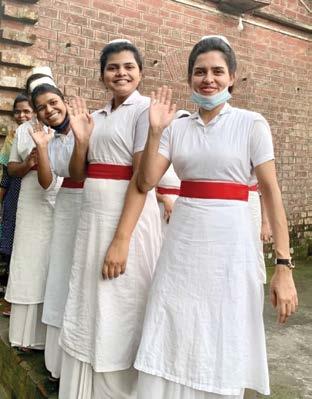
Travis Helm and Pastor Rob Guy recently returned from a 3½-week trip to Bangladesh and India. It was very cold during most of this trip, and most homes, buildings, and vehicles lack any form of heating systems. In spite of the coldness, we were very encouraged by what we experienced everywhere we visited. There is much growth in spite of the difficulties caused by the pandemic and poor living conditions throughout the areas we minister. Our time was spent encouraging, fellowshipping with, and helping strategize for the coming years ahead. The pastoral staff and teachers were starved for biblical teaching which Pastor Rob Guy provided with many extended sessions in the areas we visited. It was so exciting to interact with so many children and staff of the Mission schools, village churches, and the medical facilities. On the following few pages are pictures of the various places and people we visited during our trip.
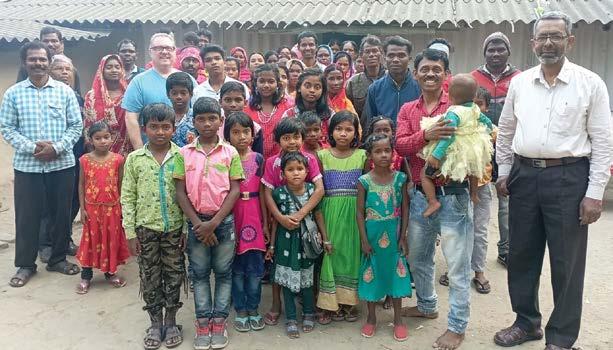
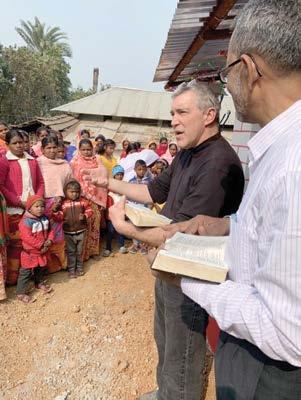


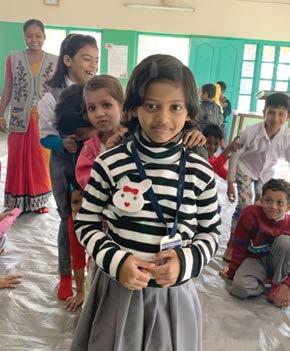



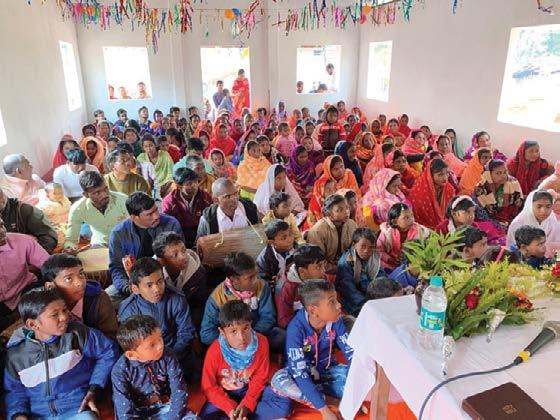

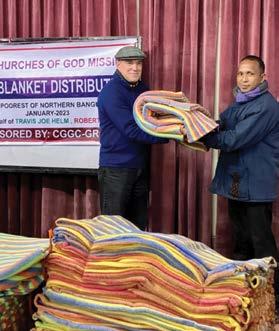
The picture below is of Ms. Basanti Samanta, our India Mission School and Child Development Center head schoolteacher and administrator. Charusheela had mentored and trained her to eventually take her place. Sadly and unexpectedly, Ms. Basanti passed away from a sudden severe stroke in mid-December after serving in Charusheela’s place for only five months. This has been devastating to our school children, Samir, and our India Mission. Please pray for them as all grieve and as we search for a qualified Christian replacement.

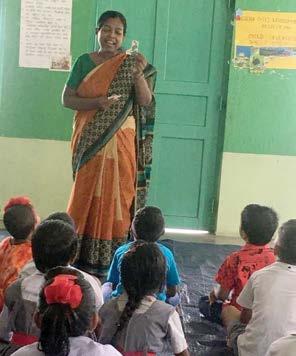

The staff at the India and Bangladesh Missions want to celebrate 125 years of existence since first being established in 1898 by missionaries from the Churches of God, General Conference. We want to honor and celebrate those who sacrificed many years ago to pave the way for what God has done through their commitment and faith. This will necessitate funds to facilitate this event that is being planned for the fall of 2023. Please consider providing a gift to Bangladesh special projects “GR 2705-125th celebration.” We anticipate needing several thousand dollars to cover food, travel, and lodging for the local leaders of both India and Bangladesh Missions as well as we host this event in Bangladesh. More information will be forthcoming about this event as we organize it.

Thank you for your faithful prayers and support in reaching the lost across the globe. It is making a difference for eternity. Enjoy the sunset over the mustard fields of India and the fruit of many years of faithful labor working in the harvest fields of Asia.
